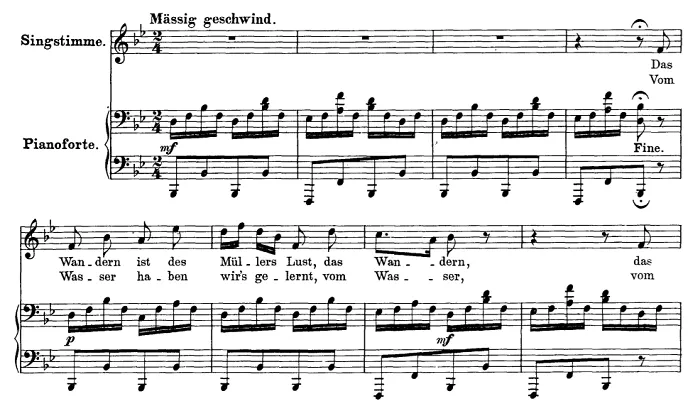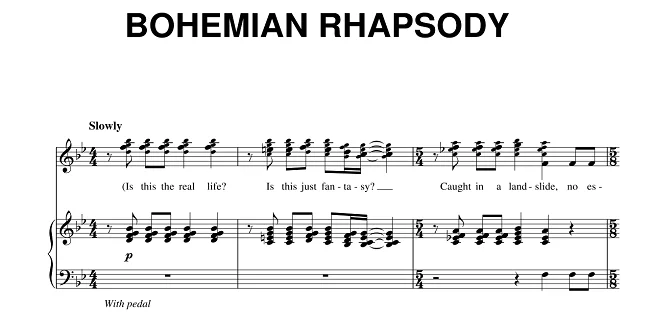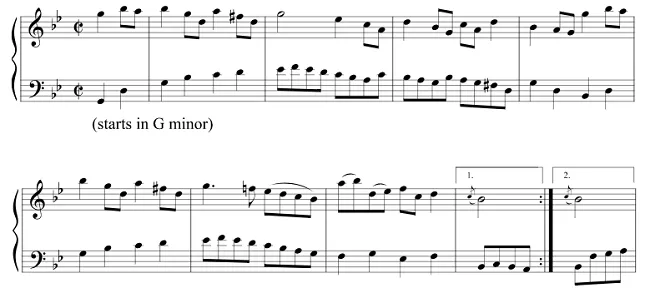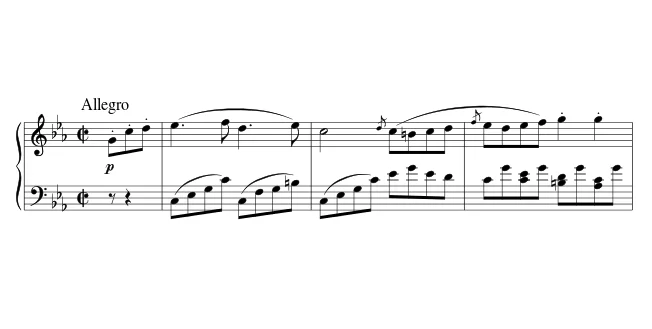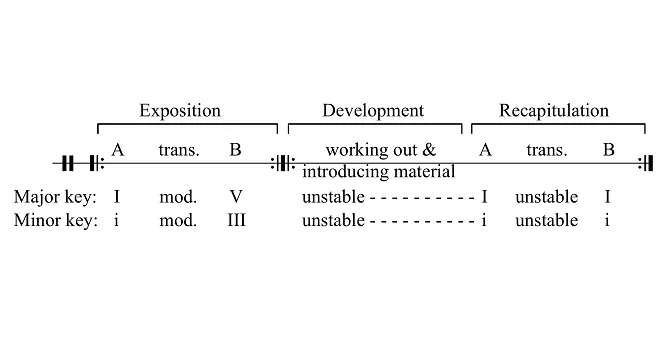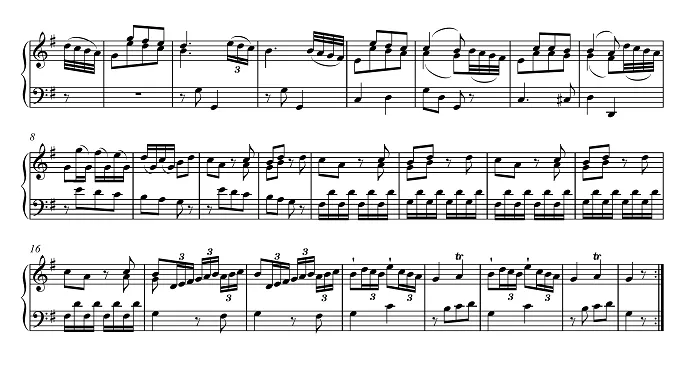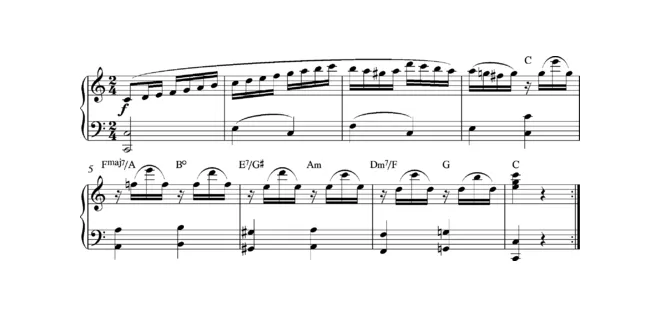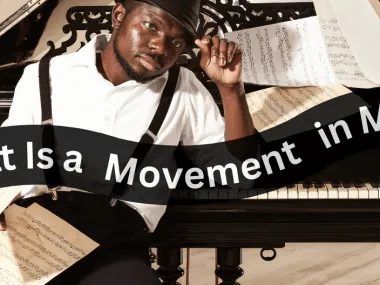Form is one of the five primary building blocks of music, sitting comfortably alongside rhythm, timbre, melody, and harmony. Although every musical element has its own purpose, a composition wouldn’t exist without form. It’s the main “blueprint” of a composition, after all!
Form in music doesn’t often get the love and attention it deserves. So, in today’s article, we’ll discuss the ins and outs of form.
What is form in music, and how is it analyzed? Let’s dive right in!
What is Form in Music?
Musical form provides integrity and shape to composition. In simpler terms, it’s the main structure of a musical composition.
Musical form usually denotes either the genre or the procedures in a specific work.
What Are the Most Common Types of Form in Music?
There are multiple types of forms in music, most of which are sectional forms. Sectional forms, as the name suggests, are built from a sequence of clear-cut sections.
Although they’re referred to by letters, they often have generic labels such as introduction, exposition, verse, chorus, and bridge.
Here are some of the most common types of forms in music:
Strophic Form
Strophic form, also known as verse form or song form, is one of the most common types of forms of music. As it features repetitiveness and a typical AAA structure, it’s the most basic of all known forms.
Due to its repetitive and simple nature, strophic forms are most commonly seen in Folk music, Pop music, and other verse-based music, as well as chants, Blues, and even Classical music.
Here are some great examples of the strophic form in music:
- Scarborough Fair.
- The Wheels on the Bus.
- Mary Had a Little Lamb.
- Amazing Grace.
- Tom Dooley.
- Deck the Halls.
Through-Composed Form
Through-composed forms in music are made up of continuous, non-sectional, and non-repetitive verses.
Unlike strophic forms where everything is repeated, through-composed forms operate independently. This means that you only hear something once. Each verse has its own unique composition, rhythm, and melody.
This type of musical composition has been widely popular in the 17th to 20th centuries. While most pieces are quite short, like some of Lieder’s more popular non-strophic works, it’s also common in hours-long opera.
A fine example of through-compose music in popular media is Bohemian Rhapsody by Queen.
Binary Form
Binary form pertains to a musical piece with two related selections, both of which are more or less of the same length. Although each section comes with a different material, it’s often closely related to the material that precedes it.
Typically, the binary form is written in one of two ways: AB or AABB. Recognizing music in binary form requires players to identify subtle changes in key signatures, rhythm, cadences, and similar harmonic adjustments.
Apart from how it’s written, binary forms can either be simple or rounded. Both may or may not feature a balanced aspect.
Simple Binary
In simple binary, the second reprise doesn’t feature the return of the opening material. It instead takes on one of two possible manifestations.
The first manifestation is simply dubbed as A’. In this manifestation, the first and second reprise isn’t repeated. The second reprise continues with about the same ideas as the first reprise.
As it never leaves the first reprise material, the concept of return isn’t applicable. In other words, material A is followed by material B, which is then moved to a dominant position.
Therefore, a piece that starts in C major, for example, will always conclude in G major.
In the second manifestation, dubbed as B, the second reprise features new material all throughout the composition.
Rounded Binary
In rounded binary, A returns in the middle of the second repeated passage.
Rules are mostly the same, except for the fact that more material is added to the B second. Typically, this material is pulled from a portion of the A section.
Binary forms – both simple and rounded – were common in 17th to 19th-century Baroque and Classical music. They’re also commonly seen in Dance music and some instances of Rock ‘n’ Roll, as seen in Louie Louie, La Bamba, and Shake, Rattle and Roll.
Ternary Form
Ternary form is a three-part musical form with third part repeats, represented as ABA. This means that the piece starts off with the main theme (A), goes to contrasting material (B), then returns to the exact same theme represented in the initial section (A).
For this reason, ternary form is usually described as “statement, digression, and restatement.”
Upon first glance, the ternary form is quite similar to the rounded binary form. However, there’s one major difference between the two: rather than having partial A material, the last section operates independently in the B section.
This means that the last section recapitulates the composition’s main theme. That said, the end material doesn’t always have to follow the exact same structure of the first A material; sometimes, the recapitulation varies slightly through tempo or rhythm.
By themselves, all three sections of the ternary form sound and appear like complete compositions. Each of the sections concludes with authentic, almost-perfect cadence and closure.
Composers put in a great deal of effort to ensure that the B section has its own defining characteristics so each section sounds like a separate composition.
One of the biggest characteristics of ternary form is mood. For instance, a player performing a piece following ternary form might start off quick and lively before slowing down upon entering the B section.
Rondo Form
In a rondo form, a piece begins with a refrain (A section) that alternates between two episodes (B and C). They usually come in two forms: 5-part rondo, which is represented by ABACA or ABABA, and 7-part rondo, represented by ABACABA.
As you may have noticed, new material is added in between each A section as the sections progress. Nonetheless, each section always returns to the A section.
Rondo form is often viewed as an extension of either binary form or ternary form. However, rondo form typically sounds much livelier than either form. This is due to the fact that it’s often played at a fast allegro tempo. Moreover, it’s repetitive and rhythmic.
If you continuously hear material from the A section returning, it’s almost always played using the rondo form. Great examples of rondo form include:
- Bach’s E major Violin Concerto.
- Mozart’s Eine Kleine Nachtmusik.
- Beethoven’s Piano Sonata Op. 13 (final movement).
- Beethoven’s Sixth Symphony.
Sonata Form
Sonata forms consist of three distinct sections: exposition, development, and recapitulation. It’s almost identical to ternary forms, which is why sonata and ternary are often used interchangeably.
However, sonata’s exposition and development follow distinct themes that don’t usually appear in ternary forms.
For instance, every half-form is harmonically enclosed. Furthermore, the development section is often thicker in terms of musical texture. Rhythms are more diverse, dynamics much broader, and chords more complex.
By many, sonata forms are considered the “first-movement form.” According to Encyclopedia Britannica, it’s the most important musical form of the Classical period up until the 20th century.
Exposition
At the beginning of the form – the exposition – we are presented with two subjects in binary form. The first subject is performed in the tonic key, while the second subject moves to the dominant.
If performed in the minor key, the piece transitions from the minor key to the relative major.
Development
Upon entering the development stage, we’re greeted with unstable harmonic structures.
Instead of settling for just one key – like what we’re given in the exposition stage – this section travels and jumps through multiple modulations.
Due to this, the development section often follows a completely new theme.
Recapitulation
The final section – recapitulation – rolls effortlessly out of the development section. It’s a clear restatement of the exposition section, often more varied and dynamic. It sometimes returns in a different key, almost as if teasing the return of the exposition material.
Most of Beethoven’s piano sonatas follow this exact pattern. It’s also commonly used by Hadyn and Mozart, as well as most solo and symphonic compositions of the Classical period.
Cyclic Form
Cyclic form involves multiple movements or sections that occur in a unifying device. In short, it’s any compositional form characterized by repetition.
Cyclic form may affect the composition’s melody, theme, or thematic material.
A song’s theme, for instance, may occur at the beginning of the composition and at the end of the composition, similar to what appears in “Brahms’s Symphony No. 3.” Other times, the theme occurs in every part in a different guise, like Saint-Saëns’s “Organ” Symphony.
Other examples include:
- Symphony No. 40 in G minor K. 550 by Wolfgang Amadeus Mozart.
- Symphony No. 31 and Symphony No. 46 by Joseph Haydn.
- Piano Sextet by Felix Mendelssohn.
Arch Form
Arch form, as the name implies, carries musical structures in the form of an arch. It’s represented by the figure ABCBA.
In arch form, every section comes with new material. Once the composition reaches the C section, the music moves in the opposite order; going back through the B material and ending the composition with the main A material.
Although played in reverse order, most sections are varied. As long as the thematic material remains untouched, composers can make changes to the rhythm and style.
Unlike most musical forms, the arch form is entirely symmetrical. In a way, it’s simply rondo form but follows symmetric order.
Arch form is most notable in Bela Bartok’s string quartet, particularly the fourth and the fifth, as well as his second piano concerto.
Medley Form
Medley form, also known as chain form, is a musical composition that plays multiple different songs one after the other, sometimes overlapping.
While most medleys are comprised of two to three songs mashed up, it isn’t rare to find more –five, six, and even seven at a time. They’re basically “mashups” of several other songs to form one coherent song.
This type of form often appears in musical theater productions and musical overture playing at the beginning of a film.
In many ways, the medley form is similar to the through-composed form. They follow the same ABCD pattern, for instance. However, unlike through-composed form, repetition appears, like AABBCCDD or an iteration around that.
Examples of medleys include the “Beach Boys Medley” by The Beach Boys and “4 Chord Song” by Axis of Awesome.
Theme and Variations Form
Theme and variation form, or simply variational form, is a musical technique wherein the material is repeated in an altered form.
Changes involve a variety of aspects, including harmony, timbre, rhythm, counterpoint, orchestration, or even a combination of all five.
However, unlike through-composed form, where every single verse is unique, this form develops the main theme throughout subsequent sections. And, as the section comes to a close, the first variation is introduced.
Mozart’s twelve variations of “Ah Vous dirai-je, Maman,” translated as, “Ah, Mother, if I could tell you,” utilizes a number of common variation techniques. Actually, you may be surprised to hear that “Ah Vous dirai-je, Maman” uses the same melody of the nursery song “Twinkle, Twinkle Little Star.”
Beethoven’s “32 Variations in C minor” is likewise a great example of the theme and variations form, as well as Johannes Brahms’s “Variations on a Theme of Robert Schumann.”
What Are the Forms Used in Popular Western Music?
Some of the most commonly used forms in Western popular music include sectional forms, extended forms, and compound forms. They’re often derived from strophic form (AAA), verse-chord form (AB), 32-bar form (AABA), and 12-bar Blues form (AAB).
Sectional Forms
Sectional forms are broken down into sections typically labeled with A, B, and C letters. They may also be identified through words, namely introduction, verse, bridge, exposition, development, etc.). For instance:
- American Popular: AABA.
- Verse/Chorus: AB.
- Verse/Chorus/Bridge: ABC.
- Verse/Chorus/Verse/Chorus: ABAB.
- Verse/Chorus/Verse/Bridge: ABAC.
- Through-composed: ABCD.
- Blues Song forms: AAB (twelve-bar Blues), eight-bar Blues, sixteen-bar Blues.
Extended Forms
Extended forms are simply sectional forms but extended with additional sections. For instance:
- AAAAA.
- AABABA.
Compound Forms
Compound forms, also known as hybrid song forms, blend two or more sectional forms in one composition. For instance, a composer may combine simple song forms like binary, ternary, or rounded binary throughout the musical piece.
Compound forms mix repetition and contrast, introducing new melodies, rhythms, and other lyrical elements to retain a sense of familiarity for the listener.
Some well-known examples of compound song forms are Roy Orbison’s Oh, Pretty Woman, Bryan Adams’ Summer of ’69, and Chuck Berry’s 1958 hit Johnny B. Goode.
What is Form in Music: Conclusion
Music thrives on structure, and that structure is called form. It’s the blueprint that holds a composition together. This includes simple strophic form found in Pop songs to the complex sonata form found in Classical concertos.
Remember that form is a guide and you should find what works for you and your music. A well-structured piece can be incredibly impactful. Using form effectively can elevate your music from good to great.

